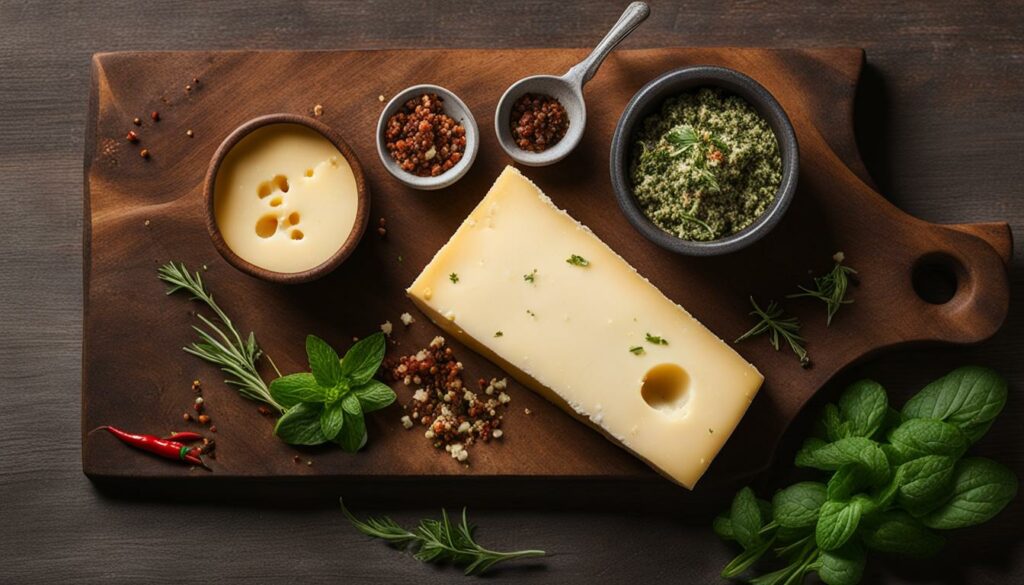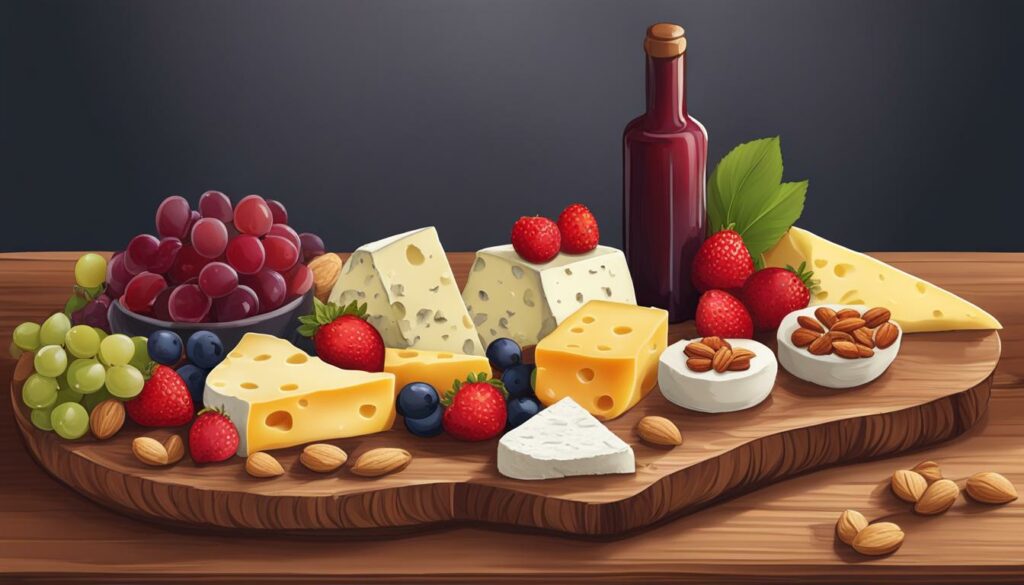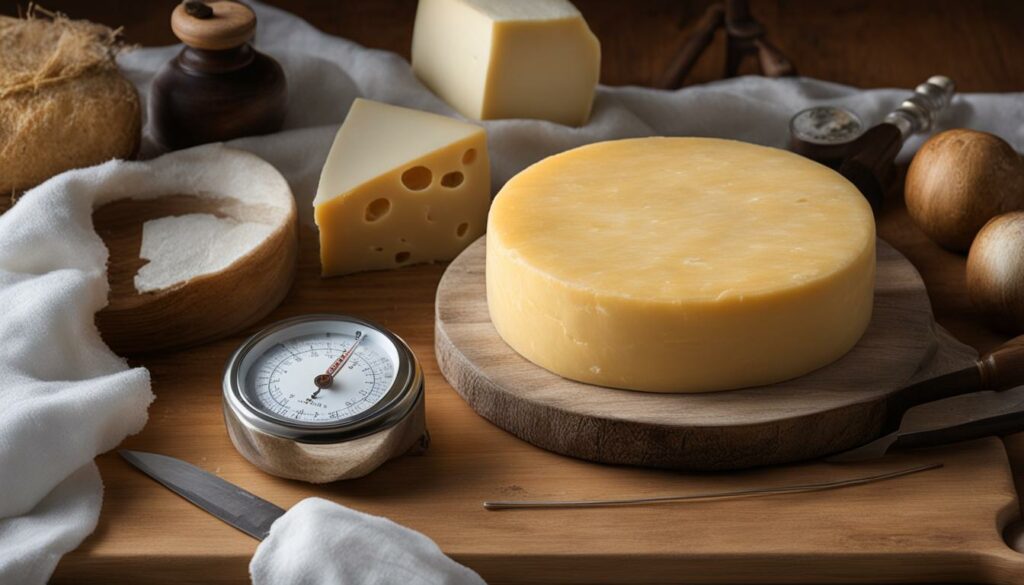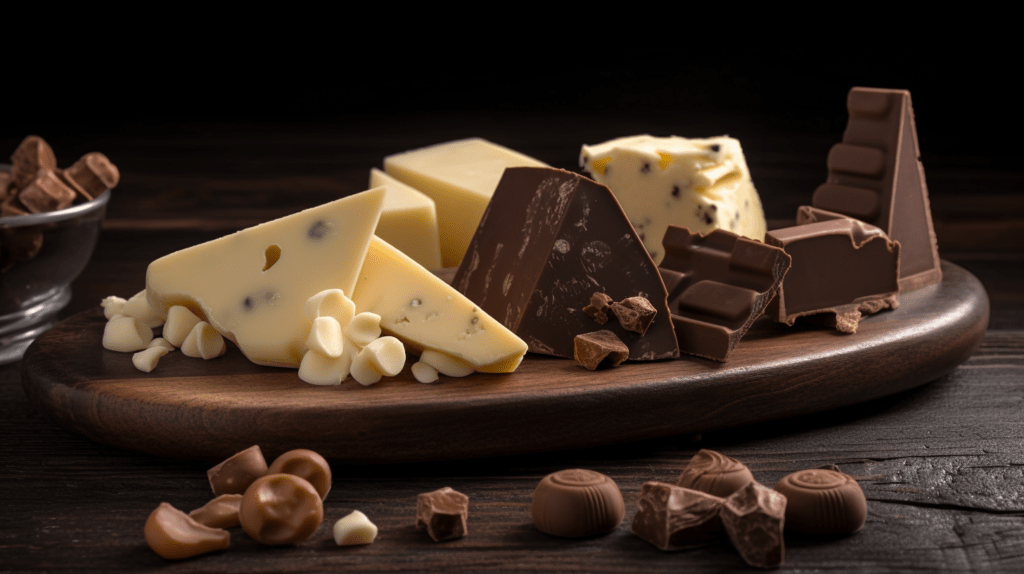Welcome to the world of Shanklish Cheese, the Middle Eastern delicacy that will transport your taste buds to the vibrant streets of Lebanon, Syria, and Egypt. This artisanal cheese, also known as shankleesh, is a true representation of Levantine cuisine and a must-try for cheese enthusiasts. With its bold and tangy taste, Shanklish Cheese is a Middle Eastern cheese unlike any other.
At Middle Eastern food stores, you’ll find this Middle Eastern cheese proudly displayed, ready to be discovered. Shanklish is an integral part of Lebanese mezze spreads and adds a unique flavor to traditional dishes. Made from coagulated yogurt, this cheese is shaped into balls and aged for at least a month to develop its distinctive taste.
The history of Shanklish Cheese dates back centuries, originating from Kurdish techniques of preserving fermented milk. This traditional cheese-making process involves straining yogurt, salting, and seasoning it before shaping it into balls. The cheeses are then left to dry in the sun and aged in airtight jars, allowing the flavors to intensify.
The flavor profile of Shanklish Cheese offers a perfect balance of tanginess and richness. As it ages, the cheese becomes more intense and sharp in taste. Shanklish can be enjoyed on its own or mixed with various spices and herbs, such as anise seeds, fennel seeds, cumin powder, or nigella seeds. Popular coatings include zaatar, sumac, chili powder, or paprika, adding an extra layer of flavor.
Not only is Shanklish Cheese delicious on its own, but it is also an incredibly versatile ingredient in Middle Eastern cuisine. Use it to create flavorful salads, top your homemade pizzas, or incorporate it into various dishes. Its unique flavor and texture will elevate any recipe and bring a taste of the Levantine region to your table.
No matter if you buy it from Middle Eastern food stores specializing in artisanal cheeses or decide to make your own, Shanklish Cheese is a stunning addition to any cheese lover’s pantry. This Middle Eastern delight is a true testament to the rich history and craftsmanship behind traditional cheese-making.
Are you ready to embark on a flavor-filled journey with Shanklish Cheese? Discover the bold and tangy flavors of the Levantine region and bring a taste of the Middle East to your next culinary adventure.
The History and Making of Shanklish Cheese
Shanklish cheese has a rich history and a fascinating traditional cheese-making process that adds to its unique flavor and character. The name “shanklish” is believed to have originated from the Kurdish words for a small terracotta pot and fermented milk, reflecting its roots in the Kurdish culture.
The origin of shanklish cheese can be traced back to Kurdistan, and over time, it has become a beloved Levantine delight, particularly in regions like Akkar in Northern Lebanon and the Syrian coastal plain around Tartus.
To create this fermented cheese, the cheese-making process begins by coagulating yogurt, followed by straining it until it reaches a dry consistency. Then, it is salted and seasoned to enhance its taste. The cheese is shaped into small balls and left to dry in the sun for a few days before being placed in airtight jars for the aging process.
During the aging period, shanklish develops a unique feature – rots on its surface. These rots contribute to the cheese’s flavorful and distinctive character, making every bite a delight for cheese enthusiasts.
This traditional cheese-making technique, rooted in Middle Eastern culture, is what makes shanklish cheese a sought-after delicacy, both locally and internationally.
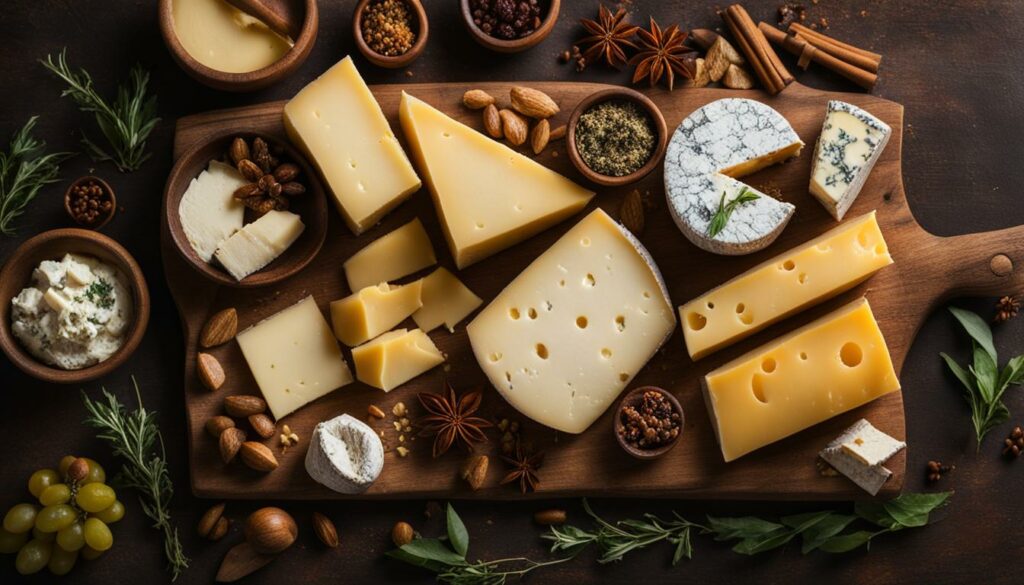
The Making of Shanklish Cheese in a Nutshell:
| Steps | Description |
|---|---|
| Coagulating Yogurt | Curdling yogurt to initiate the cheese-making process |
| Straining and Drying | Removing excess moisture by straining yogurt and drying it to achieve the desired consistency |
| Salting and Seasoning | Adding salt and other seasonings to enhance the flavor of the cheese |
| Shaping into Balls | Molding the cheese into small balls for easy handling and aging |
| Sun-drying | Drying the cheese balls in the sun, allowing them to develop a more intense flavor |
| Aging in Airtight Jars | Placing the cheese balls in airtight jars for an extended period to further enhance their flavor and develop the unique rots |
Shanklish cheese is a testament to the craftsmanship and dedication of Middle Eastern cheese-makers, providing cheese enthusiasts with a taste of traditional Levantine delight.
Flavor Profiles and Variations of Shanklish Cheese
Shanklish cheese is known for its distinct tangy flavor that develops and intensifies as it ages. The longer the cheese is aged, the sharper and more intense its taste becomes. However, it’s important to note that the flavor and texture of shanklish can vary depending on its age.
Short-aged shanklish offers a milder flavor and a softer texture, making it a great option for those who prefer a less intense cheese. On the other hand, fully matured shanklish is pungent and less creamy, appealing to those looking for a bold and robust cheese experience.
What makes shanklish cheese truly versatile is its ability to be enhanced with different spices and herbs to create unique flavor variations. Some popular additions include anise seeds, fennel seeds, cumin powder, or nigella seeds, which contribute their own distinct aromas and tastes to the cheese.
Coating Varieties
In addition to being seasoned with spices and herbs, shanklish cheese can also be coated with various ingredients to further enhance its flavors. The most common coating for shanklish in Lebanon is zaatar, a fragrant blend of herbs, sesame seeds, and sumac. This coating adds an extra layer of complexity to the cheese’s taste profile.
Other coating options include sumac, chili powder, or paprika, which impart their own unique flavors and visual appeal to the cheese. These coatings not only add flavor but also create a vibrant aesthetic, making shanklish cheese a feast for both the eyes and the taste buds.
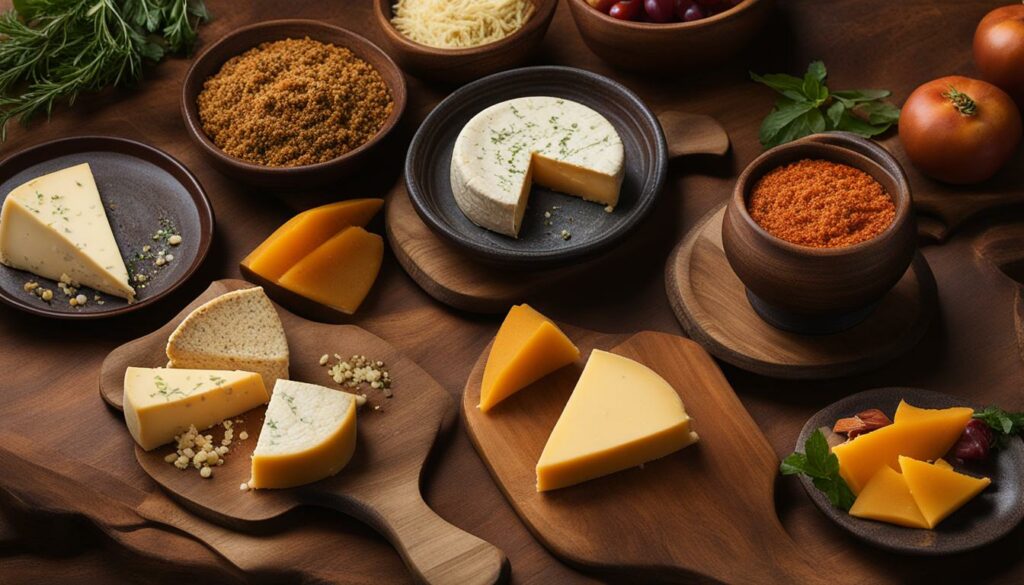
| Shanklish Cheese Varieties | Flavor Profile |
|---|---|
| Short-aged Shanklish | Milder flavor and softer texture |
| Fully matured Shanklish | Pungent and less creamy |
Shanklish Cheese: A Versatile Ingredient
Shanklish cheese is not only delicious on its own but also a versatile ingredient in Middle Eastern cuisine. Its unique flavor and texture make it an ideal addition to various dishes, adding a distinctive Middle Eastern flair. Here are some creative ways to incorporate homemade shanklish cheese into your culinary repertoire:
Create a Flavorful Salad or Mezze Dish
Crumbled shanklish cheese can be mixed with diced tomatoes, onions, and olive oil to create a refreshing and tangy salad or mezze dish. The creamy and tangy notes of the cheese complement the fresh vegetables, resulting in a burst of Middle Eastern flavors.
Top Flatbreads or Pita with Shanklish Cheese
For a Middle Eastern twist on homemade pizzas or wraps, use shanklish cheese as a topping. Its tangy and creamy characteristics add depth to the dish, creating a unique and memorable taste experience.
Infuse Middle Eastern Flavor into Omelettes and Pasta Dishes
Add crumbled shanklish cheese to omelettes or pasta dishes to infuse them with a Middle Eastern touch. The sharp and tangy flavor of the cheese enhances the overall taste, making your dishes truly exceptional.
Stuffed Vegetables with a Middle Eastern Twist
Elevate stuffed vegetables by incorporating shanklish cheese into the filling. Whether it’s peppers, zucchini, or eggplant, the cheese adds a creamy and tangy element that takes the dish to the next level.
With shanklish cheese, the possibilities are endless. Let your creativity soar and experiment with different recipes to discover new ways to enjoy the authentic Middle Eastern flavor it brings to your meals.
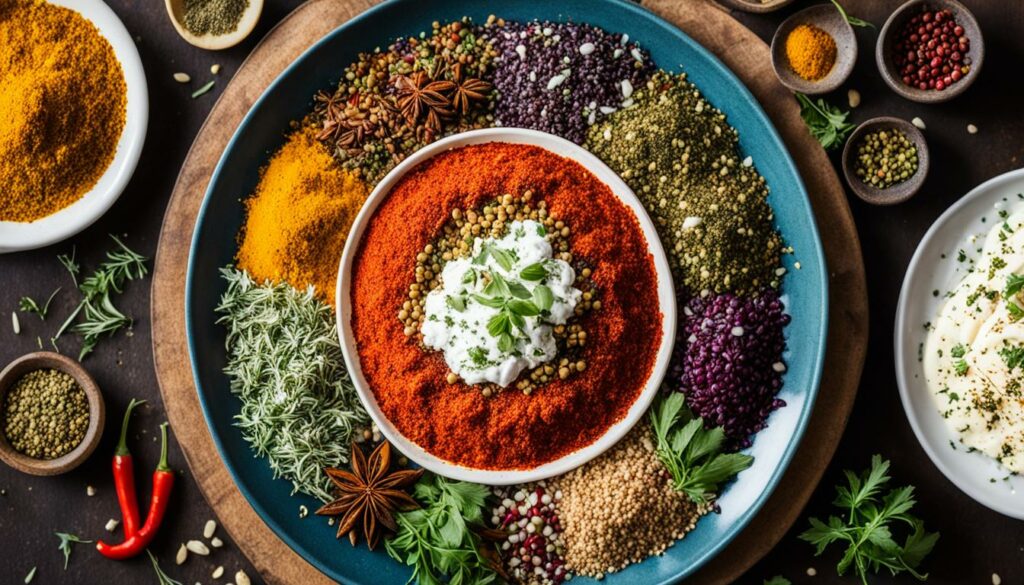
| Dish | Recipe |
|---|---|
| Shanklish Salad | Mix crumbled shanklish cheese, diced tomatoes, onions, and olive oil together. Serve as a refreshing salad. |
| Shanklish Flatbread | Top flatbread with shanklish cheese, tomatoes, cucumbers, and fresh herbs. Bake until the cheese is melted and bubbly. |
| Shanklish Omelette | Add crumbled shanklish cheese to beaten eggs and cook to make a flavorful Middle Eastern omelette. |
| Stuffed Bell Peppers | Mix shanklish cheese with breadcrumbs, herbs, and spices. Stuff the mixture into bell peppers and bake until tender. |
Buying and Storing Shanklish Cheese
If you’re craving the unique flavors of shanklish cheese, you’ll find it readily available in Middle Eastern food stores, particularly those that specialize in artisanal Middle Eastern cheeses. These stores offer a wide variety of high-quality cheeses, including shanklish, which is often sold in vacuum-sealed balls with a delicious crust of zaatar or Aleppo pepper.
If you’re feeling adventurous and want to try your hand at making homemade shanklish cheese, the process can be a labor of love. While it may take some time and effort, the result is well worth it. By making your own shanklish, you can enjoy the satisfaction of creating an authentic Middle Eastern cheese right in your own kitchen.
For those who choose to embark on the homemade shanklish journey, storing the cheese properly is key to preserving its flavors. Once prepared, wrap each ball of shanklish individually in cling film to protect it from moisture and potential flavor absorption from other foods in the refrigerator.
If you’re not planning to use the cheese right away, storing it in the freezer is an excellent option. Wrap each ball of shanklish tightly in cling film, place them in an airtight container, and label it accordingly. When you’re ready to use the cheese, simply take it out of the freezer and let it thaw in the refrigerator overnight.
Whether you opt for store-bought or homemade shanklish cheese, it’s a versatile addition to any cheese lover’s pantry. Its unique flavors and Middle Eastern heritage make it a standout ingredient that can be used in various recipes, adding that special touch of artisanal Middle Eastern cheese to your culinary creations.
Conclusion
Shanklish cheese is a unique and flavorful Middle Eastern cheese with a rich history and labor-intensive production process. Its tangy and sharp taste, which intensifies with age, has made it a favorite among cheese enthusiasts. Whether enjoyed on its own or used as a versatile ingredient in various Middle Eastern recipes, shanklish adds a touch of Middle Eastern flavor to any dish.
Whether store-bought or homemade, shanklish cheese is an artisanal cheese that brings the bold and tangy flavors of the Levantine region to your table. Its distinct taste and texture make it a perfect accompaniment to salads, flatbreads, and pasta dishes. With its tangy kick and creamy consistency, shanklish adds depth and complexity to your culinary creations.
So why not explore the world of shanklish cheese and discover the unique flavors it has to offer? Whether you’re a cheese connoisseur or a fan of Middle Eastern cuisine, shanklish will surely tantalize your taste buds. Whether you choose to enjoy it on its own or incorporate it into your favorite recipes, this Middle Eastern delight is sure to become a staple in your kitchen. Get ready to embark on a flavorful journey and experience the vibrant tastes of the Levantine region with shanklish cheese.
FAQ
What is shanklish cheese?
Shanklish cheese, also known as shankleesh, is a traditional Middle Eastern cheese that originates from Lebanon, Syria, and Egypt. It is a unique and flavorful cheese that is commonly found in Middle Eastern food stores.
How is shanklish cheese made?
The process of making shanklish cheese involves coagulating yogurt, shaping the cheese into balls, and then aging them in a dark place for at least a month. The cheese is aged, giving it a bold and tangy taste that is loved by cheese enthusiasts.
What does shanklish cheese taste like?
Shanklish cheese has a sharp and tangy flavor that intensifies with age. The longer shanklish is aged, the more intense and sharp its taste becomes. Short-aged shanklish has a milder flavor and a softer texture, while fully matured shanklish is pungent and less creamy.
How can I use shanklish cheese in cooking?
Shanklish cheese is a versatile ingredient in Middle Eastern cuisine. It can be crumbled and mixed with diced tomatoes, onions, and olive oil to create a flavorful salad or mezze dish. Shanklish can also be used as a topping for flatbreads or pita, adding a tangy and creamy element to homemade pizzas or wraps. The cheese can be incorporated into various recipes, such as omelettes, pasta dishes, or stuffed vegetables, to add a Middle Eastern flair.
Where can I buy shanklish cheese?
Shanklish cheese can be found in Middle Eastern food stores, especially those that specialize in artisanal Middle Eastern cheeses. It is often sold in vacuum-sealed balls with a crust of zaatar or Aleppo pepper.
How should I store shanklish cheese?
Homemade shanklish can be stored in the refrigerator or freezer, individually wrapped in cling film. The cheese will keep well and can be easily accessed for use in various recipes.

